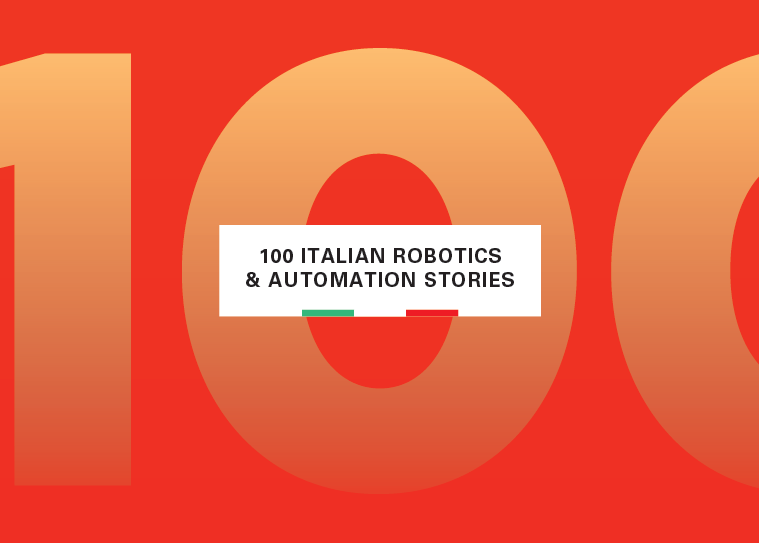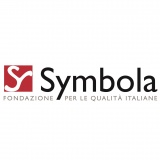
 Fondazione Symbola
Fondazione Symbola
Italian report: 100 Italian Robotics and Automation stories
- WTI Magazine #124 Feb 16, 2020
-

 Fondazione Symbola
Fondazione Symbola
Last March, in the municipality of Peccioli in Tuscany, the first robotic shopping carts were taken into service. The carts go straight to the shops’ entrances and then reach autonomously the houses of the people who made the purchases. In May, at the Gran Caffè di Rapallo, which Hemingway was known to frequent, the first two robotic waiters in Liguria and Italy were officially put into service. While in Ravello, during the summer, a robot took turns with Maestro Massimiliano Carlini in conducting the Instrumental Ensemble of the historic Salerno State Conservatoire ‘Giuseppe Martucci’.
Robots and automatons become part of everyday life, more and more present in housework, recreation or care. Their presence is already a consolidated reality in many contexts, as in that of surgical robots that improve the quality of procedures, helping patients to recover more quickly. In Italy, robotic surgery is already used in thousands of procedures per year. The automatic carts for the transport of goods and food, active 24 hours a day, every day, in many hospitals, logistics centres and in industry, are a further proof.
Worldwide, the robot market has reached a value of 16.5 billion dollars; in 2018 alone, 422,000 robots were shipped worldwide, with a 6% increase compared to the previous year. The Italian industry ranks sixth in the world in terms of total stock of installed industrial robots (69,142 units in 2018)1 , with China, Japan, South Korea, United States and Germany ahead. The 2015-2017 period has seen an increased use of robots, also due to the super-amortisation incentives on the purchase of new machinery: +48% in food; +27% in fashion; +21% in wood-furniture; +23% in metalworking2 . In production, the Italian robotics supply chain counts 104,000 companies, which have grown by 10% in five years, employing a total of 429,000 people (+17% in five years). The first province is Milan with about 12,000 companies and 110,000 employees; then Rome with 11,000 companies and 63,000 employees; followed by Naples with 5,000 companies and 13,000 employees, and Turin with 5,000 companies and 25,000 employees. Brescia, Padua, Bari, Bologna, Florence, Monza and Brianza, Bergamo and Salerno3follow with about 2,000 companies. There are realities such as that of the packaging valley, which boasts the highest concentration of manufacturers of packaging machines, with a total turnover of 7,6 billion euros in 20184 (1,5 billion of which from IMA – Industrie Macchine Automatiche – alone).
The 100 Innovation Stories Report, promoted by Enel and Symbola Foundation in cooperation with UCIMU Foundation, is now in its fourth edition, after having studied innovation in the renewable energy, circular economy and e-mobility supply chains, delves into robotics and automation, another sector of national excellence, deeply rooted in our country. Five hundred years ago the first project in history for a humanoid robot, designed by Leonardo Da Vinci, was completed. His mechanical knight, which we do not know as to whether it was ever made, must have been composed of a series of cogs that Leonardo pinned down on various pages, some of which were, and still are, to understand. Leonardo’s mechanical knight could probably move its arms, looking like an armoured soldier. Later on, during the 18th century, other inventors worked on automatons or self-propelled mechanisms. At the time, it was more about machines made to entertain and impress the observer; it had nothing to do with the robots that in the middle of last century began to populate the factories. Franco Sartorio, an Italian, was behind the birth of mechatronics. He was a pioneer of the combination of mechanics and electronics and in the 1960s he founded the Digital Electronic Automation (DEA) in Moncalieri (TO), where the Measuring Machine was produced; a device for dimensional measurements that “conquered” the world. Robots appeared in the Italian industry in the 1970s, when Fiat introduced Robogate to its plants: a robotic system for assembling car bodies, developed by the Turin-based COMAU, one of the most famous robotics companies in the world. SIRI, the Italian Robotics and Automation Association, the second association in the world in order of time (the first one was in Japan), was founded in Italy in 1975, twelve years before the foundation of the international federation.
The excellence of Italian scientific research in the field of robotics is recognised throughout the world, albeit too little in Italy. In 2015, Barbara Mazzolai and Cecilia Laschi, two of the world’s leading experts in robotics, were included in the ranking of “25 women in robotics you need to know about” by RoboHub, the largest international scientific community. Both of these women were inspired by nature in creating innovative robots. Barbara Mazzolai, director of the Center for Micro-BioRobotics of the Italian Institute of Technology (IIT) in Pontedera (PI), has created Plantoide, a robot that mimics the behavior of plants; Cecilia Laschi, Professor of Industrial Bioengineering at the Biorobotics Institute of BioRobotics of the Sant’Anna School of Advanced Studies, is one of the pioneers of soft robotics, a branch of robotics dedicated to the development of machines with soft and deformable surfaces, which created the octopus robot that, with its dexterity, offers unprecedented possibilities of use. The European Commission recently chose the Pisa-based institute as the head of the first EU network of laboratories entirely dedicated to this field. Italian robotics reaches also the infinite space: several technologies made in Italy were installed on the NASA InSight robotic lander that touched down on Mars in 2018 and on those that in 2020 will be used in the ExoMars mission to study the Martian soil, such as the Larri (Laser Retro-Reflector for InSight) retroreflective semi-sphere which will provide the position of the lander on Mars’ surface, developed by the National Institute for Nuclear Physics (INFN) with the support of the Italian Space Agency (ASI).
However, robotics in Italy crosses the boundaries of research centres and businesses, becoming a culture and a widespread passion. Many institutes teach robotics, not only on a theoretical level, enabling young people to deal directly with programming of machines and to challenge each other through competitions specifically designed for them, in which schools from all over the peninsula participate. The interest in the field is so widespread among students that Italy is the only country in the world to have its own national Zero Robotics Championship. It is an international competition in aerospace robotics, which involves the programming and management of remote-controlled robotic mini-satellites, assembled by MIT and located on board the International Space Station. The competition, which is internationally promoted by NASA, ESA, MIT and other important aerospace research centres, is coordinated by Polytechnic University of Turin, ASI, University of Padua, Rete Robotica a Scuola and the Regional Scholastic Office of Piedmont. Not by chance, the 2018/2019 World Championship finals was won by two Italian teams, the IIS Avogadro of Vercelli with its Liceo Scientifico and the Liceo Scientifico F. Cecioni of Livorno, ranked respectively first and second in alliance with U.S. teams. Recently, the students of the Istituto di Istruzione Superiore Fortunio Liceti in Rapallo were awarded a prestigious second place at the First Global Challenge of Robotics in Dubai.
Italy has also proved to be ahead in the robotic design field, with the aim of improving the comfort of the interaction between robots and people, as in the case of the robotic hand - Hannes. The prosthesis was designed by Rehab Technologies IIT - Inail Lab of Genova in collaboration with designers Lorenzo De Bartolomeis, Gabriele Diamanti and Filippo Poli (ddp studio) and was awarded by the Association for Industrial Design with the National Prize for Innovation “ADI Design Index 2018”.Moreover, the collaboration between the Higher Institute for Artistic Industries (ISIA) of Florence and the Sant’Anna School of Advanced Studies in Pisa was created to develop projects in that direction. Design and ergonomics also come into play in the creation of exoskeletons and other robotic devices that in the future will support human work by improving efficiency and reducing the risk of accidents and injuries, allowing workers to perform less risky activities being more focused on management or product customisation.
Robotics studies deal also with human and artificial intelligence and also in this field there is a strong commitment of our country, which has been at the forefront for many years. In 2014, Italy hosted the first international conference on robotics (a term coined in 1942 by the scientist and science fiction writer Isaac Asimov) about the implications of the interaction between algorithms, robots and humans, and to promote and encourage the development of robotics for the well-being of individuals and society at large. The researches also include the progressive reduction of low-skilled and arduous jobs in favor of an increase in high-skilled jobs, even if completely new and creative.
This is the country pictured by Enel and the Symbola Foundation in this fourth report on Made in Italy innovation, from domestic robots to space rovers, from the major centres of international excellence to the passion for robotics that runs through the young Italian generations from the south to the north of Italy. A narrative that without demanding completeness - despite the well-known limitations and problems - tells about technologies that improve the quality of lives of citizens in hospitals as well as at home, ease the tasks of workers in factories and increase safety standards. These are important innovations for many sectors, from automotive to agri-food and logistics. 100 experiences that once again prove that if Italy makes Italy, it is able to overcome any challenge thanks to its ability to combine functionality, design and well-being. This is the product of a culture that - even during periods of technologically advanced challenges - never forgets the paramount role of research, creating a people-oriented economy and society.
Francesco Starace (CEO of ENEL) and Ermete Realacci (President of Symbola Foundation)